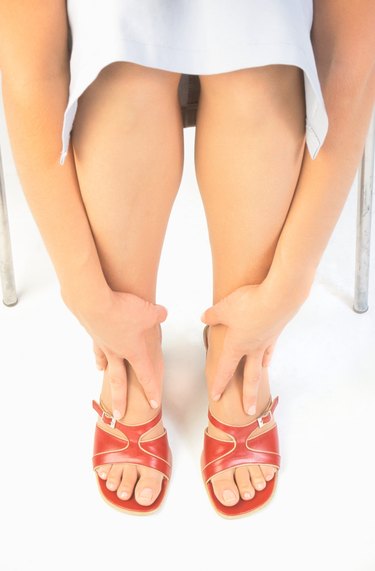Things You'll Need
Newspaper
Acetone
Soft cloths
Rubber gloves
Masking tape
Leather or vinyl paint
Disposable plate
Paintbrush

Pleather, or faux leather, is a synthetic fabric made with a plastic coating designed to emulate the look of real leather. As with many other plastics and vinyl, not all paints adhere well to pleather. Some paint may adhere for a while, but crack or peel off when the fabric flexes and moves. Acrylic paints specially formulated to work on vinyl, leather or faux leather adhere to pleather. Layering on the paint in thin coats produces the most durable results, with a thin base coat to start off the paint-layering process.
Step 1
Place a sheet of newspaper on the ground or on an outdoor work surface. Set the pleather project atop the paper.
Video of the Day
Step 2
Dab some acetone onto a soft cloth while wearing rubber gloves. Buff the area of the pleather that you wish to paint using the acetone to prepare it for painting. While this step is optional, acetone helps remove some of the shiny coating on the pleather, which makes the paint adhere better. Wipe the buffed area again with a damp cloth, then allow the pleather to dry completely.
Step 3
Apply masking tape to areas you wish to keep paint-free.
Step 4
Pour some of the paint onto a disposable plate. Dip the brush into the paint and apply a light, thin coating over the pleather. Allow the base coat to dry completely; with some leather paints, drying takes only 15 to 20 minutes.
Step 5
Apply a second layer of paint over the first, keeping the second coat thin as well. Allow the paint to dry completely between coats, slowly building up the paint layers until the color looks solid and consistent.
Tip
Layer colors atop one another, if desired, once the first color dries. For instance, if you're painting a smiley face, allow the multiple coats on the yellow face to dry completely, then add the eyes and smile in the desired color, which may take more than two coats.
Test the acetone on a small area of the pleather before applying it all over the entire project. Start with a small amount of acetone rather than dousing the entire project to prevent damage.
A vinyl or plastic spray paint may be used in place of a leather paint.
Warning
Work with acetone outdoors on a non-windy day to avoid breathing in its strong fumes. If you must work indoors, work in a well-ventilated area and wear a dust mask to help avoid breathing the fumes.
Video of the Day